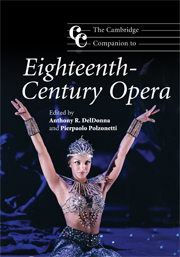Book contents
- Frontmatter
- Part I The making of opera
- Part II National styles and genres
- 9 Genre and form in French opera
- 10 Genre and form in German opera
- 11 Opera in eighteenth-century England: English opera, masques, ballad operas
- 12 Opera in Naples
- 13 Portugal and Brazil
- 14 Opera, genre, and context in Spain and its American colonies
- Notes
- Bibliography
- Index
14 - Opera, genre, and context in Spain and its American colonies
from Part II - National styles and genres
Published online by Cambridge University Press: 28 September 2011
- Frontmatter
- Part I The making of opera
- Part II National styles and genres
- 9 Genre and form in French opera
- 10 Genre and form in German opera
- 11 Opera in eighteenth-century England: English opera, masques, ballad operas
- 12 Opera in Naples
- 13 Portugal and Brazil
- 14 Opera, genre, and context in Spain and its American colonies
- Notes
- Bibliography
- Index
Summary
Opera had a richly textured history in eighteenth-century Spain and its empire, though a relatively small number of fully sung operas in Spanish were produced in the period. In the peninsular capitals, Madrid, Barcelona, Valencia, and Cádiz, and in the administrative centers of its colonies, Naples, Palermo, Lima, and Mexico City, operas and musical plays were performed in a variety of situations, public and private, and sponsored by both aristocratic patrons and eager entrepreneurs. The history of opera in this period is intertwined with the history of musical theater, given that opera coexisted with several types of partly sung entertainment (zarzuela, tonadilla escénica, and sainete) and embraced a number of musical styles. The classic Spanish comedia – a three-act, tragicomedic genre that usually included songs in verisimilar situations – was still widely performed in the early 1700s. Indeed, scholars now recognize that its conventions were extremely influential well into the eighteenth century. In part, this influence remained vigorous because the traditional mechanisms for theatrical administration and financing were so well engrained. Public theaters, known as corrales, continued to present spoken theater with almost daily performances for an eager audience, much as they had almost continuously since the opening of the first purpose-built public theaters in Madrid and elsewhere just before 1600.
- Type
- Chapter
- Information
- The Cambridge Companion to Eighteenth-Century Opera , pp. 244 - 269Publisher: Cambridge University PressPrint publication year: 2009
- 2
- Cited by



